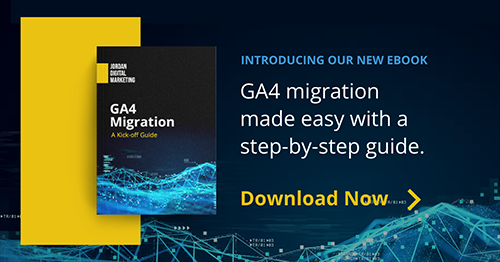If your job involves paid search, and you’re reluctant to embrace AI, Google is about to force your hand. That’s the big takeaway after a slew of AI-empowered announcements made at Google Marketing Live 2023 on Tuesday.
In this post, we’ll outline a few non-AI updates and then dive into some eye-opening new (or fast-approaching) features that will take a lot of manual uplift off of marketers’ hands – for better or worse.

Google Marketing Live updates - non-AI division
While Performance Max is grounded in AI, marketers will have access to a number of enhancements that won’t require additional AI adoption. Those include:
- Performance-based reporting and enhanced recommendations in Auction Insights, an expanded search term category report, and reporting on creative assets
- More precision bidding options to target new and/or high-value customers
- Note: this is currently available for selected advertisers; if you don’t yet have access, make sure you’re prepping for your turn by identifying values for all relevant conversion types
- Broad match brand controls that afford advertisers additional reach while maintaining brand guidelines
For Shopping accounts, Google Merchant Center is releasing capabilities including a direct-to-website feed connection that saves time on manual uploads. Advertisers will get controls on how products appear without having to upload feeds. And the UI will offer advertisers insights on the competitor landscape, top-performing products, and pricing benchmarks.
Finally, Google is providing new reporting functionality under Display and Video 360. Now available in beta, the reporting shows a full breakdown of your CTV campaign performance alongside other campaigns, which may be a signifier that Google is betting on CTV to gain budget share in marketing campaigns.
Google Marketing Live - AI updates
Conversation Experience
The first one we’ll cover might be the event’s biggest eye-popper. With this feature, advertisers will chat directly with Google AI during campaign setup; the AI function can take a simple URL, spit out a business description, and (once approved) will work from there to generate keywords, headlines, sitelinks, etc. If this sounds like it’s a thing of the 22nd century, think again - it’s expected to start rolling out in July.
Asset creation through Generative AI
Generative AI is already here, of course, but Google is refining the function to make ad copy more relevant to customer queries while staying true to your product or service offering. The idea is for search queries to trigger dynamic headlines and descriptions – and this is something we’ll plan to test and QA extremely diligently before rolling out at any kind of scale.
Performance Max will have an AI twist on this, of course; using the Conversational Experience, PM will take a URL and create headlines and imagery – although the process makes advertisers approve the assets before pushing them live (which is a very necessary step).
Lastly, later this year, Shopping campaigns will be able to access Google’s generative AI tool to create images for the product feed.
Conversation ads for search
We’ve all wondered how AI chat in search engines will affect the UX and layout of ads. With conversation ads, users type queries into Google’s generative AI, and ads are placed within the list of products in the response – which is similar to Microsoft’s ChatGPT search advertising experience. Conversation ads will generate listings using advertisers’ landing pages in tandem with existing ads.
Users can ask follow-up questions, and context is carried from question to question. Google’s touting the process as a collaborative one in which users’ prompts and questions can make the ads more relevant.
GA4 Audience Builder
Advertisers who haven’t yet made the switch from Universal Analytics to GA4 have one more reason to prioritize the cutover: you can now build audiences directly in GA4. AI is powering predictive audience segmentation including likely 7-day purchases, likely 7-day purchasing churners, likely 28-day purchasers, etc.
If it’s proven effective enough for Google to release it publicly, this could help advertisers find and reach users more likely to purchase.
Demand Gen for YouTube
YouTube is now offering AI-powered lookalike segmentation (narrow, balanced, and broad) to help advertisers reach new customers with introductory video content. This gives a much-needed layer of nuance to demand gen and lets marketers find a balance of cost effectiveness with scale in filling the top of the funnel.
Is your head spinning yet? You’re not alone. Over the coming weeks and months, we’ll be diving into the efficacy and best practices of some of GML’s bigger releases. Keep an eye on the JDM blog for more updates - and reach out to us if you'd like to talk!
